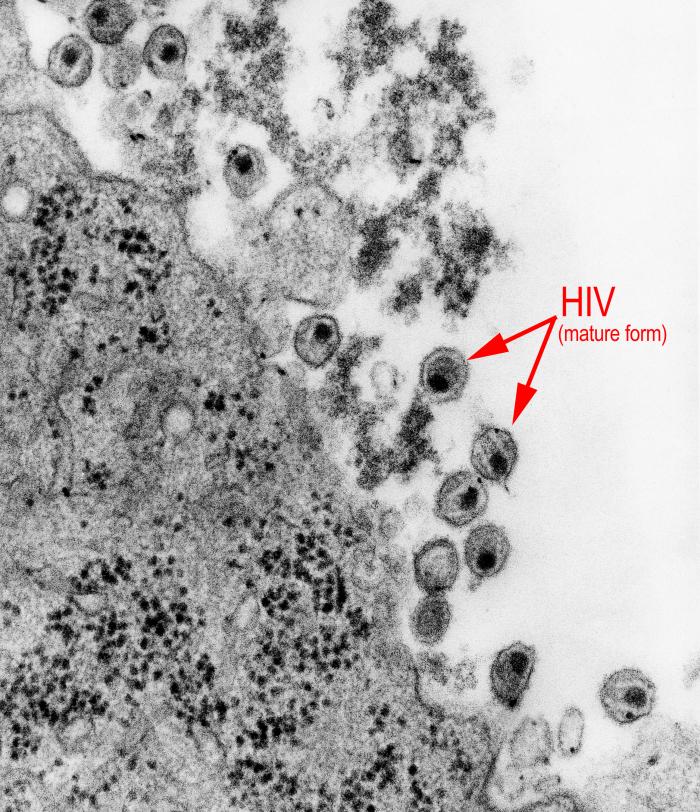
This web page was produced as an assignment for an undergraduate course at Davidson College.
Andrew Johnson's Pathogen Webpage: HIV

Figure 1. Above is a transmission electron micrographic image showing HIV virons in a tissue sample. The photo is from the Public Health Image Library - ID# 8254 - CDC
In early 1981, doctors in New York City began seeing unprecedented numbers of Kaposi's sarcoma and Pneumocystis pneumonia (Altman, 1984). Both diseases were considered very rare and usually only seen in individuals with weakened immune systems. By fall 1981, CDC studies were showing high concentrations of the bizarre afflictions among promiscuous, homosexual men in New York City and California. Theories in the medical community suggested everything from an amoeba carrying a new virus to suppression of the immune system from overexposure to sperm (Henig, 1983). Over the next year, new outbreaks were seen among intravenous-drug users, hemophiliacs and females who had sexual relations with drug users. In 1983, French researchers announced the discovery of a virus termed LAV thought to be the cause of AIDS (Henig, 1983). LAV was isolated from lymph nodes of a homosexual man who claimed to have over 50 partners each year. The same man had also spent time traveling through Africa, multiple European countries and a trip to New York in 1979. In 1984, US researchers announced the development of a reliable test for HTLV-3 - believed to be the same pathogen as the Lav virus. While the numbers of AIDS cases were rising, some researchers believed a vaccine would be in testing in the next two years.(Altman, 1984). To date, 21.8 million people have died from AIDS (Office of National AIDS Policy, 2007). Currently, there are more than 40 million people living with HIV/AIDS (Rubbert et al, 2006) and 15,000 new infections occurring every day (Office of National AIDS Policy, 2007).
It is now known that there are two distinct types of HIV, known as HIV-1 and HIV-2. Both types lead to AIDS, but HIV-2 is not as easily transmitted and seems to progress more slowly (AVERT, 2007). HIV-2 is more similar to SIV and contains different accessory proteins than HIV-1 (Rubbert et al, 2006). As the vast majority of HIV infected individuals are positive for HIV-1, HIV-1 will be the focus of this web page.
Sections:
Treatment and Future Directions
References:
Altman, Lawrence K. 1984 April. New U.S. Report Names Virus That May Cause AIDS. The New York Times. <http://query.nytimes.com/gst/fullpage.html?res=9A0CEEDD1238F937A15757C0A962948260&sec=health&spon=&pagewanted=1>. (12 February 2007).
Henig, RM. 1983 Feb 6. AIDS A New Disease's Deadly Odyssey. The New York Times Magazine. <http://query.nytimes.com/gst/fullpage.html?sec=health&res=9C0CE6D7163BF935A35751C0A965948260>. (12 February 2007).
Noble, Rob. Introduction to HIV types, groups and subtypes. AVERT (25 April 2007). <http://www.avert.org/hivtypes.htm>. (5 May 2007).
Office of National AIDS Policy. Fact Sheet The HIV/AIDS Epidemic: 20 Years in the U.S. <http://www.whitehouse.gov/onap/facts.html>. (12 February 2007).
Rubbert, A., et al . 2006. Pathogenesis of HIV-1 Infection. In: Hoffmann, C., Rockstroh, J., Kamps, B., editors. HIV Medicine 2006. Flying Publisher. <http://www.hivmedicine.com/index.htm>. (5 May 2007).